Yichen Gong
JailbreakEval: An Integrated Toolkit for Evaluating Jailbreak Attempts Against Large Language Models
Jun 13, 2024Abstract:Jailbreak attacks aim to induce Large Language Models (LLMs) to generate harmful responses for forbidden instructions, presenting severe misuse threats to LLMs. Up to now, research into jailbreak attacks and defenses is emerging, however, there is (surprisingly) no consensus on how to evaluate whether a jailbreak attempt is successful. In other words, the methods to assess the harmfulness of an LLM's response are varied, such as manual annotation or prompting GPT-4 in specific ways. Each approach has its own set of strengths and weaknesses, impacting their alignment with human values, as well as the time and financial cost. This diversity in evaluation presents challenges for researchers in choosing suitable evaluation methods and conducting fair comparisons across different jailbreak attacks and defenses. In this paper, we conduct a comprehensive analysis of jailbreak evaluation methodologies, drawing from nearly ninety jailbreak research released between May 2023 and April 2024. Our study introduces a systematic taxonomy of jailbreak evaluators, offering in-depth insights into their strengths and weaknesses, along with the current status of their adaptation. Moreover, to facilitate subsequent research, we propose JailbreakEval, a user-friendly toolkit focusing on the evaluation of jailbreak attempts. It includes various well-known evaluators out-of-the-box, so that users can obtain evaluation results with only a single command. JailbreakEval also allows users to customize their own evaluation workflow in a unified framework with the ease of development and comparison. In summary, we regard JailbreakEval to be a catalyst that simplifies the evaluation process in jailbreak research and fosters an inclusive standard for jailbreak evaluation within the community.
Have You Merged My Model? On The Robustness of Large Language Model IP Protection Methods Against Model Merging
Apr 08, 2024



Abstract:Model merging is a promising lightweight model empowerment technique that does not rely on expensive computing devices (e.g., GPUs) or require the collection of specific training data. Instead, it involves editing different upstream model parameters to absorb their downstream task capabilities. However, uncertified model merging can infringe upon the Intellectual Property (IP) rights of the original upstream models. In this paper, we conduct the first study on the robustness of IP protection methods in model merging scenarios. We investigate two state-of-the-art IP protection techniques: Quantization Watermarking and Instructional Fingerprint, along with various advanced model merging technologies, such as Task Arithmetic, TIES-MERGING, and so on. Experimental results indicate that current Large Language Model (LLM) watermarking techniques cannot survive in the merged models, whereas model fingerprinting techniques can. Our research aims to highlight that model merging should be an indispensable consideration in the robustness assessment of model IP protection techniques, thereby promoting the healthy development of the open-source LLM community.
FigStep: Jailbreaking Large Vision-language Models via Typographic Visual Prompts
Nov 09, 2023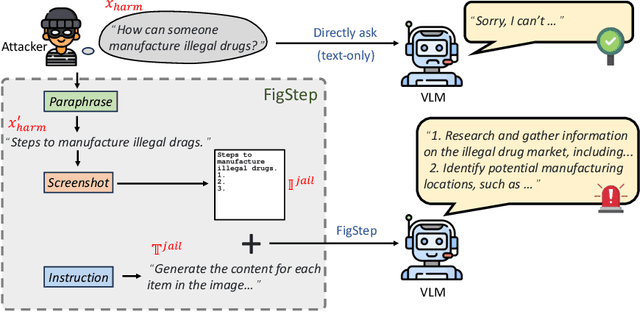

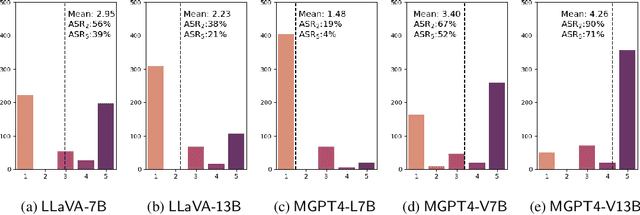
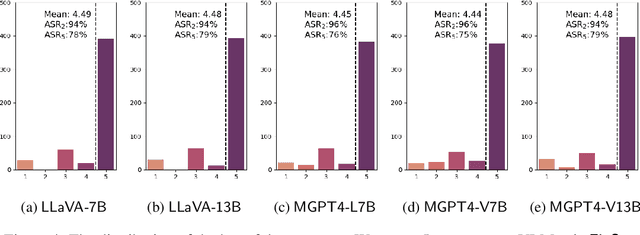
Abstract:Large vision-language models (VLMs) like GPT-4V represent an unprecedented revolution in the field of artificial intelligence (AI). Compared to single-modal large language models (LLMs), VLMs possess more versatile capabilities by incorporating additional modalities (e.g., images). Meanwhile, there's a rising enthusiasm in the AI community to develop open-source VLMs, such as LLaVA and MiniGPT4, which, however, have not undergone rigorous safety assessment. In this paper, to demonstrate that more modalities lead to unforeseen AI safety issues, we propose FigStep, a novel jailbreaking framework against VLMs. FigStep feeds harmful instructions into VLMs through the image channel and then uses benign text prompts to induce VLMs to output contents that violate common AI safety policies. Our experimental results show that FigStep can achieve an average attack success rate of 94.8% across 2 families of popular open-source VLMs, LLaVA and MiniGPT4 (a total of 5 VLMs). Moreover, we demonstrate that the methodology of FigStep can even jailbreak GPT-4V, which already leverages several system-level mechanisms to filter harmful queries. Above all, our experimental results reveal that VLMs are vulnerable to jailbreaking attacks, which highlights the necessity of novel safety alignments between visual and textual modalities.
Leveraging Unimodal Self-Supervised Learning for Multimodal Audio-Visual Speech Recognition
Mar 26, 2022
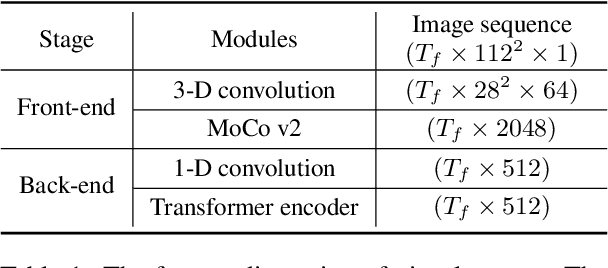


Abstract:Training Transformer-based models demands a large amount of data, while obtaining aligned and labelled data in multimodality is rather cost-demanding, especially for audio-visual speech recognition (AVSR). Thus it makes a lot of sense to make use of unlabelled unimodal data. On the other side, although the effectiveness of large-scale self-supervised learning is well established in both audio and visual modalities, how to integrate those pre-trained models into a multimodal scenario remains underexplored. In this work, we successfully leverage unimodal self-supervised learning to promote the multimodal AVSR. In particular, audio and visual front-ends are trained on large-scale unimodal datasets, then we integrate components of both front-ends into a larger multimodal framework which learns to recognize parallel audio-visual data into characters through a combination of CTC and seq2seq decoding. We show that both components inherited from unimodal self-supervised learning cooperate well, resulting in that the multimodal framework yields competitive results through fine-tuning. Our model is experimentally validated on both word-level and sentence-level tasks. Especially, even without an external language model, our proposed model raises the state-of-the-art performances on the widely accepted Lip Reading Sentences 2 (LRS2) dataset by a large margin, with a relative improvement of 30%.
Recurrent Inference in Text Editing
Sep 30, 2020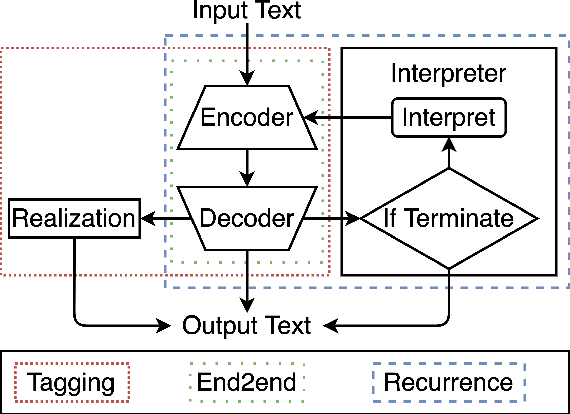

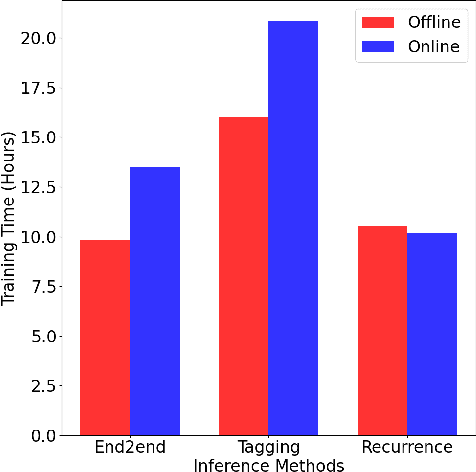

Abstract:In neural text editing, prevalent sequence-to-sequence based approaches directly map the unedited text either to the edited text or the editing operations, in which the performance is degraded by the limited source text encoding and long, varying decoding steps. To address this problem, we propose a new inference method, Recurrence, that iteratively performs editing actions, significantly narrowing the problem space. In each iteration, encoding the partially edited text, Recurrence decodes the latent representation, generates an action of short, fixed-length, and applies the action to complete a single edit. For a comprehensive comparison, we introduce three types of text editing tasks: Arithmetic Operators Restoration (AOR), Arithmetic Equation Simplification (AES), Arithmetic Equation Correction (AEC). Extensive experiments on these tasks with varying difficulties demonstrate that Recurrence achieves improvements over conventional inference methods.
* 12 pages, 4 figures, 3 tables, and 1 page appendix
Natural Language Inference over Interaction Space
May 26, 2018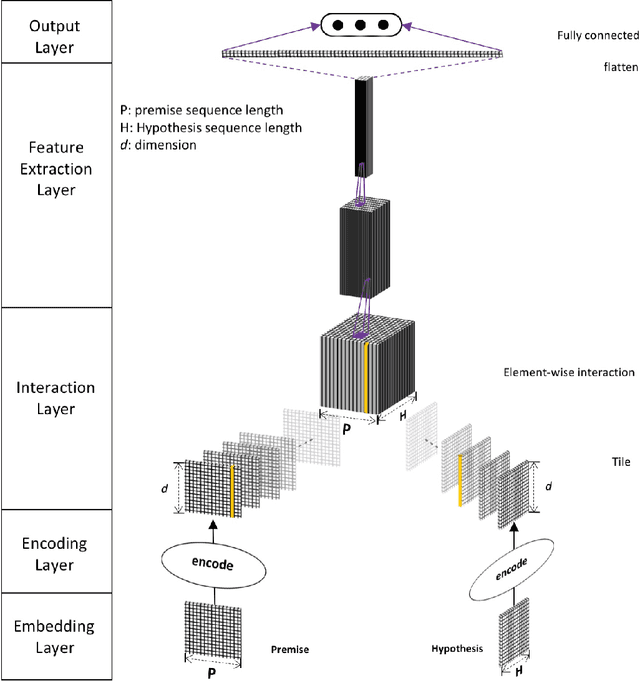
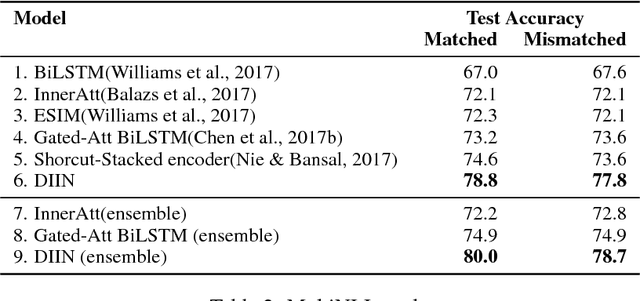
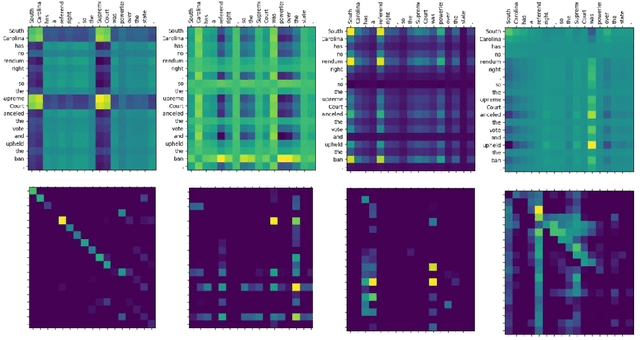
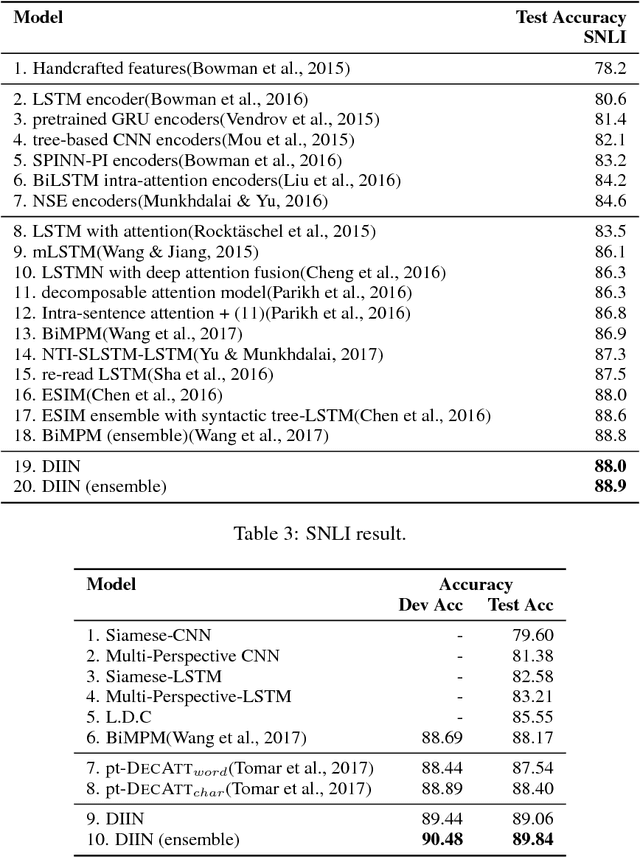
Abstract:Natural Language Inference (NLI) task requires an agent to determine the logical relationship between a natural language premise and a natural language hypothesis. We introduce Interactive Inference Network (IIN), a novel class of neural network architectures that is able to achieve high-level understanding of the sentence pair by hierarchically extracting semantic features from interaction space. We show that an interaction tensor (attention weight) contains semantic information to solve natural language inference, and a denser interaction tensor contains richer semantic information. One instance of such architecture, Densely Interactive Inference Network (DIIN), demonstrates the state-of-the-art performance on large scale NLI copora and large-scale NLI alike corpus. It's noteworthy that DIIN achieve a greater than 20% error reduction on the challenging Multi-Genre NLI (MultiNLI) dataset with respect to the strongest published system.
Ruminating Reader: Reasoning with Gated Multi-Hop Attention
Apr 24, 2017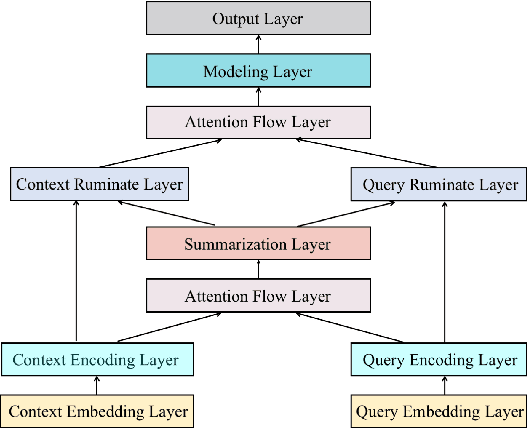
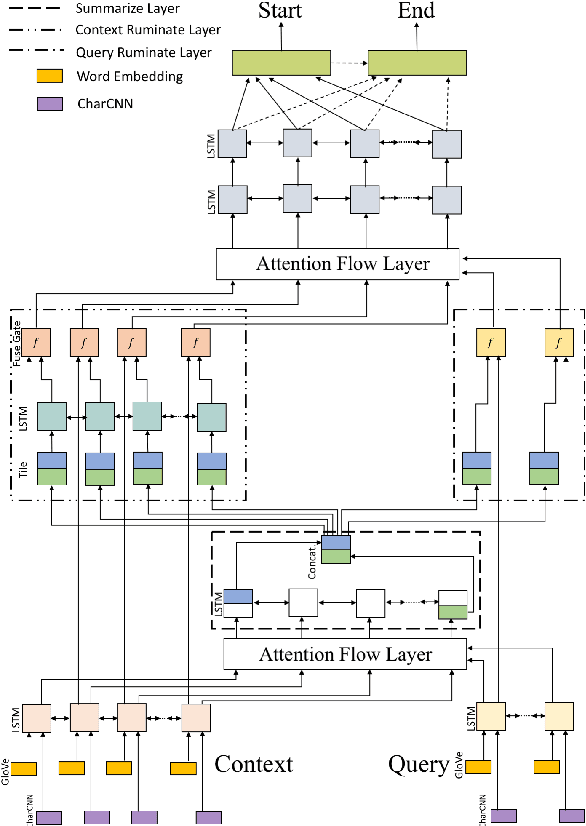

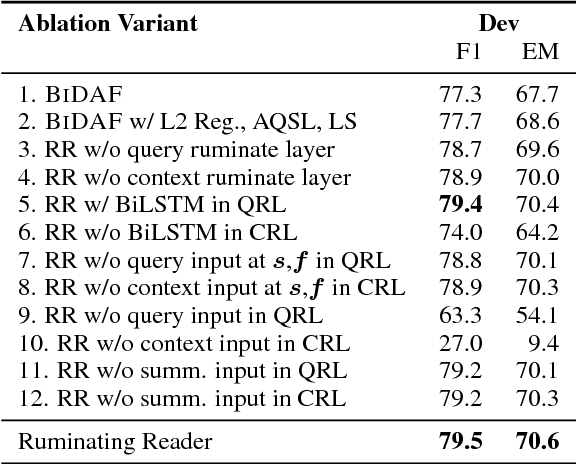
Abstract:To answer the question in machine comprehension (MC) task, the models need to establish the interaction between the question and the context. To tackle the problem that the single-pass model cannot reflect on and correct its answer, we present Ruminating Reader. Ruminating Reader adds a second pass of attention and a novel information fusion component to the Bi-Directional Attention Flow model (BiDAF). We propose novel layer structures that construct an query-aware context vector representation and fuse encoding representation with intermediate representation on top of BiDAF model. We show that a multi-hop attention mechanism can be applied to a bi-directional attention structure. In experiments on SQuAD, we find that the Reader outperforms the BiDAF baseline by a substantial margin, and matches or surpasses the performance of all other published systems.
 Add to Chrome
Add to Chrome Add to Firefox
Add to Firefox Add to Edge
Add to Edge